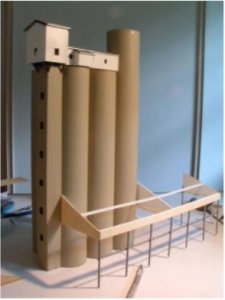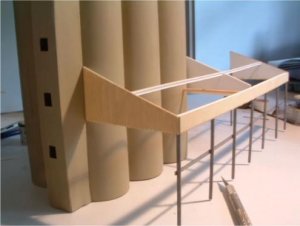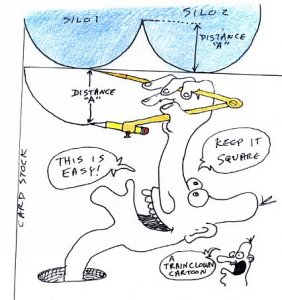Guys,
Hope you can provide me with some nifty ideas here.
My latest project is a wheat silo, and loading dock. But I've got a bit of a problem with the roof. (pic below).
The cylinders (silos) are 255mm in diameter, and the roof of the loading dock is at 65 degrees from the perpendicular. (20 degree slope).
I need to cut some pieces that will fit slugly up into the silo cylinders, however, the cut out piece will not be semi circular, due to the angle of incidence with the cylinders. (they'll need to be cut in a semi "elipse".)
Truoble is, I've no idea (other than hit 'n' miss) how to get a good cut and fit for it.
I'm going to use corrugated iron (not real stuff), and its actually metal (aluminium), so I really need it to be very accurate. One slip and the whole sheet is wasted really.
Any ideas? If I have some 3D modeling software etc, I could do it, and print off a template, and use that, but I don't have the software.
I've thought of using some very thin card, hit 'n' miss cutting to get it right, but I'm sure there's an easy way of juggling "something somehow" to get the curve I need.
Any help is really appreciated.
Thanks.
Hope you can provide me with some nifty ideas here.
My latest project is a wheat silo, and loading dock. But I've got a bit of a problem with the roof. (pic below).
The cylinders (silos) are 255mm in diameter, and the roof of the loading dock is at 65 degrees from the perpendicular. (20 degree slope).
I need to cut some pieces that will fit slugly up into the silo cylinders, however, the cut out piece will not be semi circular, due to the angle of incidence with the cylinders. (they'll need to be cut in a semi "elipse".)
Truoble is, I've no idea (other than hit 'n' miss) how to get a good cut and fit for it.
I'm going to use corrugated iron (not real stuff), and its actually metal (aluminium), so I really need it to be very accurate. One slip and the whole sheet is wasted really.
Any ideas? If I have some 3D modeling software etc, I could do it, and print off a template, and use that, but I don't have the software.
I've thought of using some very thin card, hit 'n' miss cutting to get it right, but I'm sure there's an easy way of juggling "something somehow" to get the curve I need.
Any help is really appreciated.
Thanks.





